Acute
In 1847 a new workhouse was built by the Paddington Guardians to house its poor, as the neighbouring Kensington workhouse, which had been used until then, had become too crowded.
The Paddington workhouse was located on the north bank of the Grand Union Canal, to the south of Harrow Road. In 1868 its sick wards were extended and new offices and a dispensary also added.
In 1883 work began on a separate infirmary building, which was sited between the workhouse and the adjacent Lock Hospital. It would cost £1,100 and contain six wards, including a lying-in ward and a lunatic observation ward, as well as a dispensary. A midwife was engaged and a Relieving Officer for the dispensary, but the contractors went bankrupt and the infirmary was not completed until 1885.
The Paddington Infirmary opened in 1886. It was a long 4-storey building with a basement, and lay on a north-south axis. It contained 284 beds, although some sick beds remained in the workhouse itself, giving a total of 295 beds altogether. Male patients were accommodated in the south part and female in the north. Distinctly shaped towers at each end of the building contained the bathrooms and WCs.
In 1886 the Medical Officers of the Marylebone and Paddington Infirmaries approached St Mary's Hospital Medical School with a view to establishing cooperation in clinical instruction for medical students. They were turned down (a prevailing snobbery of the time resulted in teaching hospital staff looking down on those employed in infirmaries).
In 1890 most of the workhouse inmates - some 90% - were aged over 65 years, but the Infirmary was admitting an increasing number of younger acute cases.
By 1907 there was a great need for a Nurses' Home but a minority of the Board of Governors, backed by a large number of ratepayers, protested against its cost of £10,000. The Board decided it was more economical to adapt existing buildings for the purpose.
In 1913 25% of admissions to the Infirmary were children under the age of 10 years, half of whom were discharged within a month. Only 5% remained for six months or more.
In 1919 Dr Charles Wilson(later Lord Moran), the future Dean of St Mary's Hospital Medical School, saw the advantages of a link with the Marylebone and Paddington Infirmaries, which could supply a wealth of clinical material not available in a general hospital. The Paddington Board of Guardians agreed to the proposal that medical students could visit and receive clinical instruction at the Infirmary. (It seems that the medical staff of the Infirmary were better qualified than those of the workhouse.) Thus, clinical lectures were held at the Infirmary, allowing it to claim that it was the only metropolitan infirmary where such instruction (normally restricted to general hospitals) had been attempted.
As the medical care improved due to the link with St Mary's Hospital, more non-pauper patients began to seek treatment at the Infirmary, with their expections of better care higher than those of the workhouse paupers.
In 1921 the nurses finally got their Nurses' Home. As the number of beds had risen to 594 and the number of operations had increased to over 200 a year, so had the number of nursing staff. A reduction in hours worked by the nurses also meant more had to be employed, thus creating an even greater necessity for a Nurses' Home. The new Home was opened by the Earl of Onslow, Parliamentary Secretary to the Minister of Health, as was an up-to-date operating theatre, bringing the Infirmary more towards the standing of a general hospital.
The operating theatre was spacious, with a north and a top light, and painted in cream, rather than the usual dazzling white. The anaesthetic room was painted green, while the sterilising room was lined with white tiles. The surgeon's room was also painted cream. The floors of the theatre and its annexes were tesselated throughout. Small round windows were inset into the plain doors leading to the theatre, so that the progress of an operation could be observed without opening the door. Above the operating table was a great lamp with reflectors (on the principle of a lighthouse lamp), which was movable freely latitudinally, but not longitudinally.
The Nurses' Home provided each nurse with a separate bedroom. The sitting room walls were painted cream, with green woodwork and a carpet of Aubusson colouring.
In 1929 control of the workhouse and Infirmary transferred to the LCC, who renamed the site the Paddington Hospital.
In 1935 the Hospital had 605 beds.
In 1948 it joined the NHS under the control of the Paddington Group Hospital Medical Committee, part of the North West Metropolitan Regional Health Board.
In 1954 it became Paddington General Hospital.
In 1968 it affiliated with St Mary's Hospital in Praed Street and was renamed St Mary's Hospital (Harrow Road) or, more colloquially, St Mary's Harrow Road. The St Mary's Hospital Group also contained St Charles' Hospital, Paddington Green Children's Hospital and the Western Ophthalmic Hospital.
In 1971 the remedial therapies (physiotherapy, occupational therapy and speech therapy) were integrated into one department. In 1977 Rheumatology and Rehabilitation wards were opened - the first in the District - but were forced to close in 1979, when the first serious financial cuts affected the NHS.
In 1981 the Hospital had 431 beds, but the Area Health Authority decided that there were too many acute beds in the District, and that the service would be concentrated at the Praed Street site and at St Charles' Hospital. Thus, the Casualty Department and the acute beds closed at Harrow Road. In 1984 a special Rheumatology ward opened again, shared with patients from the Oral Surgery Unit.
By 1985 there were 166 beds. The Hospital was due to be closed once Phase 1 of the rebuilding of its mother hospital in Praed Street was completed but, due to financial pressures, it closed prematurely. The last Out-Patient clinic was held on 31st October 1986 and the wards finally closed on 22nd November. Services were transferred to St Mary's Hospital in Praed Street.
Present status (January 2010)
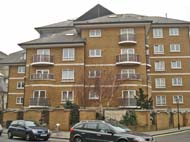
New housing, comprising some 582 residential units, now dominates the site (above and below).
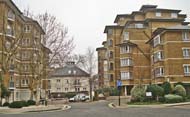

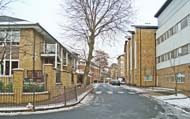
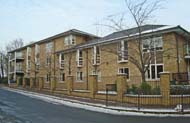

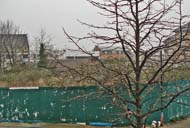
The only part of the Hospital site yet to be redeveloped is in the southeast corner.
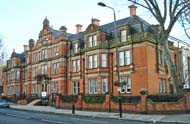
The administration offices of the Paddington Guardians at 317 Harrow Road were adjacent to the workhouse.


From 1965 the building has been used as offices by the City of Westminster, when the Town Hall in Paddington Green was demolished to make way for the new Westway. It also contains the City of Westminster's 'One stop services'.
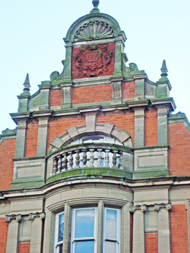
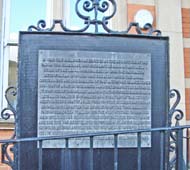
At the top of the gable, the coat of arms of the Borough of Paddington (permitted in 1902) depicts two wolves heads with two crossed swords and a mural crown. A plaque by the entrance door explains the history of the building.
(Author unstated) 1921 An up-to-date training school. The Paddington Infirmary. British Journal of Nursing, 10th December, 367-368.
Brown K 1994 Workhouse to hospital: the experience of Paddington General from Infirmary to St Mary's Hospital, Harrow Road. St Mary's Gazette 100, 40-42.
Carter M 1987 St Mary's Hospital, Harrow Road, W9, 1847-1986. St Mary's Gazette 93, 15-17.
http://hansard.millbanksystems.com
www.british-history.ac.uk
www.phr.org.uk
www.workhouses.org.uk
Return to home page